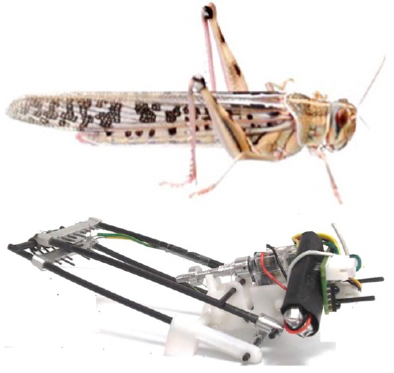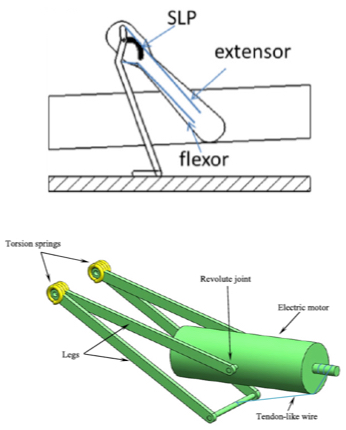‘Robot locust’ can jump 11 feet high
December 18, 2015

Locust-inspired TAUB robot (credit: Tel Aviv University)
A locust-inspired miniature robot that can jump 3.35 meters (11 ft.), covering a distance of 1.37 meters (4.5 ft.) horizontally in one leap is designed to handle search-and-rescue and reconnaissance missions in rough terrain.
The new locust-inspired robot, dubbed “TAUB” (for “Tel Aviv University and Ort Braude College”), is 12.7 cm (5 in.) long and weighs weighs 23 grams (less than one ounce). It was developed by Tel Aviv University and Ort Braude College researchers.
The ABS plastic body of the robot was 3D-printed, its legs are composed of stiff carbon rods, and its torsion springs of steel wire. A small on-board battery powers the robot, which is remotely controlled via an on-board microcontroller.
Torsion springs

Locust vs. robot leg models (credit: Tel Aviv University)
A locust catapults itself in a three-stage process. First, the legs are bent in the preparation stage. Then the legs are locked in place at the joint. Finally, a sudden release of the flexor muscle on the upper leg unlocks the joint and causes a rapid release of energy.
This creates a fast-kicking movement of the legs that propels the locust into the air.
Like the locust, which uses stored mechanical energy to enhance the action of its leg muscles, the robot’s “high-jump” is due to its ability to store energy in its torsion springs.
The researchers are currently working on a gliding mechanism that will enable the robot to extend its jumping range, lower its landing impact, execute multiple steered jumps, and stabilize while airborne, expanding the possible field applications of the robot.
Abstract of A locust-inspired miniature jumping robot
Unmanned ground vehicles are mostly wheeled, tracked, or legged. These locomotion mechanisms have a limited ability to traverse rough terrain and obstacles that are higher than the robot’s center of mass. In order to improve the mobility of small robots it is necessary to expand the variety of their motion gaits. Jumping is one of nature’s solutions to the challenge of mobility in difficult terrain. The desert locust is the model for the presented bio-inspired design of a jumping mechanism for a small mobile robot. The basic mechanism is similar to that of the semilunar process in the hind legs of the locust, and is based on the cocking of a torsional spring by wrapping a tendon-like wire around the shaft of a miniature motor. In this study we present the jumping mechanism design, and the manufacturing and performance analysis of two demonstrator prototypes. The most advanced jumping robot demonstrator is power autonomous, weighs 23 gr and is capable of jumping to a height of 3.35m, covering a distance of 1.37m.